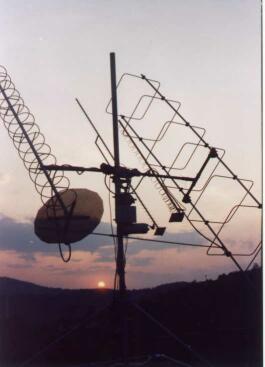Zoltán OM7AQ bol prvý, ktorý reagoval na našu prosbu o príspevok na CQ.sk. Ponúkol nám možnosť publikovať jeho staršie články. Ďakujeme!

Dnes Vám prinášame článok o amatérskych satelitoch. Je to obšírny materiál o satelitnej komunikácii, technike aj prevádzke a slovenských staniciach venujúcich sa tejto pútavej oblasti rádioamatérstva.
Rádioamatérske družice umožňujú lepšie využívať veľmi krátke vlny – od dolnej hranice krátkovlnného pásma až do mikrovlnných pásiem. Na palube družice je obvykle prevádzač – transpondér – ktorý podobne ako pozemný prevádzač má vstupný a výstupný kmitočet – uplink a downlink. Väčšina družíc má na palube lineárny prevádzač – na prevádzky SSB a CW, ale sú aj také satelity ktoré majú FM transpondér.Družice môžu byť nízkodráhové (LEO) – ako napr. RS-12, RS-15, FO-20, FO-29, atď.a vysokodráhové (HEO) – ako napr. AO-10, AO-13 alebo AO-40.
Prvá rádioamatérska družica – OSCAR 1 – bola vypustená v roku 1961. Na palube mala len maják. Družica OSCAR 3, vypustená v roku 1965 už mala lineárny transpondér 145 MHz/145MHz. V roku 1972 a 1974 boli úspešne vypustené družice OSCAR 6 a OSCAR7.Na začiatku 80-tich rokoch úspešne odštartoval ruský amatérsky družicový program RS.
Po úspešnom štarte OSCAR 10 ozajstná DX prevádzka sa stala skutočnosťou aj cez satelity. Dlho plánovaná superdružica OSCAR 40 dnes je tiež skutočnosťou.

Pre každý družicový mód na uplink (vstupná frekvencia) musíme mať vysielač a na downlink (výstupná frekvencia) prijímač s príslušnými anténami. Každý mód družice má doporučený efektívny vyžiarený výkon pozemnej stanice (ERP alebo EIRP) – túto hodnotu by sme nemali prekročiť. Dodržiavaním doporučeného ERP (EIRP) sa vyhneme rušeniu ostatných staníc a pre seba zabezpečíme bezpečnú a stabilnú prevádzku.
Pre družice LEO (RS-12, FO-20, atď.) potrebujeme samozrejme menší výkon (okolo 100 W ERP – menší výkon vysielača a jednoduchá anténa) a pre družice HEO (AO-10, AO-40) väčší výkon (okolo 200-300 W ERP na CW a 800-900 W ERP na SSB – väčší výkon vysielača a viacprvkové smerové antény ).

Náš prijímač by mal byť citlivý – na príjem môžeme použiť nízkošumové predzosilňovače umiestnené priamo pod anténou.
Pokusy môžeme robiť so ľubovoľnými anténami, ale pre serióznu prácu budeme potrebovať vhodné antény. Pre družice LEO v oblasti KV pásiem – 29 MHz – môžeme použiť antény dipól, krížený dipól, ale aj GP ,LW alebo smerové antény. Pre VKV pásma – 145 MHz – tiež je vhodné použiť antény so širokým vyžarovacím diagramom – odpadajú problémy so smerovaním antén. Pre družice HEO môžeme použiť klasické konštrukcie VKV antén, ale je lepšie používať antény pre kruhovú polarizáciu – krížové yagi, alebo Helix. Je nutnosťou otáčanie antén v oboch rovinách – horizontálne a vertikálne AZ/EL.

Na sledovanie družíc môžeme využívať počítač – existujú satelitné programy pre rôzne platformy – DOS, Windows 9x, Linux, atď.
Pred prvými pokusmi preštudujeme frekvenčný plán danej družice. Frekvenčné plány môžeme získať zo siete PR BBS alebo na Internete. Interný bandplán družice treba dodržať. Vyberieme si vhodný oblet – pre prvé pokusy sú vhodnejšie také oblety, keď transpondér je málo obsadený. Keď máme smerové antény, tak nasmerujme ich na družicu. Prijímač naladíme na frekvenciu majákového vysielača.
Vplyvom Dopplerovho posunu prijímaná frekvencia nebude rovnaká s menovitou frekvenciou. Keď začujeme signály majákového vysielača, tak môžeme hľadať stanice vo frekvenčnom pásme prevádzača družice. Nájdime voľné miesto a zakľúčujme vysielač, pritom dovtedy krúťme ladiacim gombíkom vysielača – samozrejme v rozsahu uplink frekvencií družice – kým nebudeme na prijímači počuť vlastné signály. Ak sa to podarilo, tak môžeme volať výzvu – SSB alebo CW. Pri SSB prevádzke treba dávať pozor: niektoré družice majú invertujúci transpondér. To znamená, že aby na downlink (výstup) počuli USB signál, tak na uplink (vstup) musíme vysielať LSB. Také sú družice AO-10, FO-20, FO-29. Postup môže byť aj opačný – na prijímači nájdeme stanicu, ktorá volá výzvu. Vysielačom sa naladíme na jej frekvenciu – presvedčíme sa, či počujeme vlastné signály – ak áno, tak pravdepodobne bude aj protistanica nás počuť. Pri prevádzke dbajme na to, aby vlastné signály neboli silnejšie ako signály majákového vysielača družice. Zapamätajme si: pracovať s veľkými výkonmi je paráda, ale pokaziť radosť druhých nie je nič dobrého…

Okrem družíc, ktoré majú lineárne transpondéry, sú aj také satelity, ktoré majú na palube jednokanálový FM prevádzač, alebo digipeater, resp. BBS. Družice s crossband FM prevádzačom, ako napr. AO-27 a UO-14 sú využiteľné aj technicky menej vybaveným staniciam: na prevádzku by mala stačiť dvojpásmová „rúčka“ s anténou na 2m/70cm. Digi družice, obvykle používajú protokol ako pozemné packetrádio – AX.25, rýchlosť 1200 Bd (BPSK/AFSK), a 9600 Bd (FSK/FSK). Okrem družíc sú zapojení do amatérskej kozmickej komunikácie aj orbitálne komplexy – kozmické stanice. Veľkú popularitu získala medzi amatérmi ruská vesmírna stanica MIR a tiež medzinárodná kozmická stanica ISS – je možná aj hlasová FM prevádzka, ale aj digitálna (packetová) komunikácia
Slovenské stanice na satelitoch
OM7AQ – op: Zoli,QTH: Lučenec
QRV cez všetky aktívne analógové satelity
Zariadenia: 2m: FT290R, PA100W/preamps, 4, 2×5, 13 ele. 70cm: FT790R, PA100/350W/preamps,2×15 ele. 13cm dish
Iné: QRV HF/VHF/UHF
e-mail: gye@isternet.sk
web: http://om7aq.host.sk
OM3WBC – op: Joe,QTH: Fiľakovo JN98VG
QRV cez všetky aktívne analógové satelity
Zariadenia: ICOM IC910H,PA 100W/preamps., 2m: 2×13 ele F9FT,70cm: 2×19 ele
Iné: QRV na 2m/70cm/23cm (tropo, Es…)
ax.25: OM3WBC@OM0PBB.#SSL.SK.EU
OM0MS – op: Števo,QTH: Humenné KN08
QRV cez všetky aktívne analógové satelity
Zariadenia: 2m: home made 50W, 70cm: IC471H,PA 300W/preamps.9ele/19 ele
Iné: KV pásma a 70cm EME
e-mail:om0ms@QSL.net
ax.25: OM0MS@OM0PBB.#SSL.SVK.EU
web: http://www.qsl.net/om0ms
OM3WAN – op:Alojz,QTH: Žilina
QRV cez všetky aktívne analógové satelity a AO-40
Zariadenia: home made 2m TCVR 30W/trnsv. 70cm 30W,ant. 4ele/9 ele
Iné: 2m/70cm 13 cm: DB6NT konv.+1m dish
OM1AVK – op:Vlado,QTH: Bratislava
QRV cez všetky aktívne satelity
Zariadenie: ICOM IC 821H,PA 100W/preamps,ants. 9/21 ele F9FT
Iné: 2m/70cm
e-mail:vrm1@pobox.sk
ax.25: OM1AVK@OM0PBM.#ZSL.SVK.EU
Cez LEO pracujú/pracovali tieto slovenské stanice
OM3TPS,OM8RA,OM8AMY,OM7AC,OM0AB,OM3TPG (nw OM3BH),OM3AU (silent key),OM3KII,OM3MM,OM9FI,OM3KEG,OM1II,OM3IM,OM3TLF, OM3GB, OM3LU,OM3CPY (nw OM7PY),OM3CFL,OM3IS,OM3CAF,OM3WAO
gye@isternet.sk
http://om7aq.host.sk
